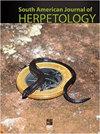潮间期进食:两种海岸觅食蜥蜴的饮食、能量学和渗透关系
IF 0.7
4区 生物学
Q4 ZOOLOGY
引用次数: 2
摘要
摘要由于海洋环境对爬行动物具有潜在的高渗和高盐环境压力,因此生活在海水中或附近的爬行动物对其摄食行为及其渗透和离子调节生理具有特殊的兴趣。我们测定了两种类人猿的潮间觅食种群的饮食、野外代谢率(FMRs)、水流入和流出率,以及渗透调节的各个方面。这两种类人猿是Galápagos群岛上的白斑小蜥和智利北部阿塔卡马沙漠上的阿塔卡马小蜥。雄性M. albemarlensis只吃螃蟹,专门吃小的Sally Lightfoot螃蟹的腿,而小得多的雌性喜欢吃昆虫,但也吃整个小螃蟹。相比之下,阿塔卡camensis的雄性和(同样较小的)雌性都主要吃海藻,以及一些螃蟹和昆虫。这两个物种的成虫在高渗饮食中保持恒定的体重,尽管亚成虫阿塔卡camensis在我们的研究中体重下降。这两个物种的fmr,假设是由于渗透调节的额外能量消耗而很高,实际上相对较低,平均为65% (M. albemarlensis)和78% (M. atacamensis)的预期fmr。然而,水通量是典型的自由生活爬行动物,平均分别为预测率的79%和116%。albemarlensis的血浆和尿液中的渗透浓度是典型的蜥蜴,但M. atacamensis的血浆中渗透浓度高出约50%(498±42 mOsm),可能反映了不可避免的结果,甚至是适应了它们较高的饮食渗透物含量(饮食中的海藻“汁液”中有1680 mOsm)。讨论了其他可能的适应,以促进利用不寻常的饮食项目和摄取海水。特别是,鼻盐腺和尿液沉淀物在两种物种的渗透调节和离子稳态中的作用可能很重要,但目前尚不清楚,应该进行研究。本文章由计算机程序翻译,如有差异,请以英文原文为准。
Dining Intertidally: Diet, Energetics, and Osmotic Relations of Two Shoreline-Foraging Tropidurid Lizard Species
Abstract. Because marine environments present potentially stressful hyperosmotic and hypersaline situations for reptiles, those species that live in or near seawater are of special interest regarding their feeding and drinking behavior and their osmotic and ionic regulatory physiology. We determined diets, field metabolic rates (FMRs), rates of water influx and efflux, and aspects of osmoregulation in intertidally foraging populations of two congeneric species of tropidurid lizards: Microlophus albemarlensis in the Galápagos Islands and M. atacamensis in the Atacama Desert of northern Chile. Male M. albemarlensis ate only crabs, specializing on the legs of small Sally Lightfoot crabs, while the much smaller females favored insects but ate whole small crabs as well. In contrast, M. atacamensis males and (the also smaller) females both ate mainly seaweed, along with some crabs and insects. Adults of both species were maintaining constant body masses on these hyperosmotic diets, although subadult M. atacamensis lost mass during our study. FMRs of both species, which were hypothesized to be high due to presumed extra energy costs of osmoregulation, were actually comparatively low, averaging 65% (M. albemarlensis) and 78% (M. atacamensis) of expected FMRs for lizards of their body mass. However, water flux rates were typical of free-living reptiles, averaging 79 and 116%, respectively, of predicted rates. Osmotic concentrations in blood plasma and urine of M. albemarlensis were typical of lizards in general, but plasma of M. atacamensis was about 50% higher (498 ± 42 mOsm), perhaps reflecting an unavoidable consequence of, or even an adaptation to, their higher dietary osmolyte content (1,680 mOsm in “sap” of dietary seaweed). Other possible adaptations that facilitate exploitation of unusual diet items and ingestion of seawater are discussed. In particular, the roles of nasal salt glands and urinary precipitates in osmoregulation and ion homeostasis of both species are likely important but are currently unknown and should be studied.
求助全文
通过发布文献求助,成功后即可免费获取论文全文。
去求助
来源期刊
CiteScore
1.50
自引率
0.00%
发文量
10
期刊介绍:
The South American Journal of Herpetology (SAJH) is an international journal published by the Brazilian Society of Herpetology that aims to provide an effective medium of communication for the international herpetological community. SAJH publishes peer-reviewed original contributions on all subjects related to the biology of amphibians and reptiles, including descriptive, comparative, inferential, and experimental studies and taxa from anywhere in the world, as well as theoretical studies that explore principles and methods.

 求助内容:
求助内容: 应助结果提醒方式:
应助结果提醒方式:


